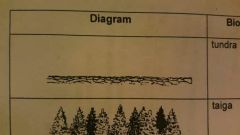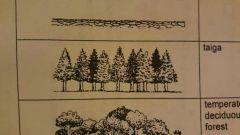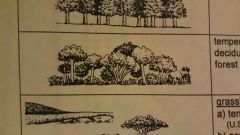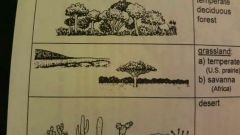![]()
![]()
![]()
Use LEFT and RIGHT arrow keys to navigate between flashcards;
Use UP and DOWN arrow keys to flip the card;
H to show hint;
A reads text to speech;
35 Cards in this Set
- Front
- Back
|
Abiotic |
Physical environment |
|
|
Biotic |
Other organisms |
|
|
The niche of an organism included such things as |
-kind of food -place lies + reproduces -time of day active -way it affects environment -resources provides for others |
|
|
Symbiosis "living together" |
Organism of different species that live together in a close association |
|
|
Commensalism |
One organism bennefits, other not affected (+,0) |
|
|
Mutualism |
Both organisms benefit (+,+) |
|
|
Competition |
Plays * role in ecosystem development. Easily seen when needed habitats are formed |
|
|
Ecological Succession |
New habitat formed, one community replaces another through competition until stable stage |
|
|
Climax Community |
Stable community (ecological Succession stops) |
|
|
Pioneer Organisms |
First organisms to colonize new habitat and initiate the process of Succession -don't stay long (out competed) -make more habitabl -change env.. pave the way |
|
|
Primary Succesion |
No previous growth Ex. Volcanic island -longer time |
|
|
Secondary Succession |
Has been previous growth Ex. Forest clearing |
|
|
Forest Climax community |
What ponds and lakes eventually develop into -begins with things accumulating on bottom (⬇depth) -around edges sphagnum mods and rooted plants grow into water (extend banks, ⬇size) -fills in=rich in nutrients=support large population of organisms=⬆ organisms= ⬆ organic material to sediment (hastens filing process) -lake becomes marsh -dry land forms |
|
|
When does Succession stop? |
During Succession, the stability of an ecosystem ⬆ Stability=ability if an ecosystem to resist change in face of disturbance Last stage = absorb disruption without major change better then predecessors |
|
|
What promotes stability? |
-diversity -more diverse= more complex Web of interactions= more likely to find an alternate food source if lost |
|
|
Why are some ecosystems more diverse then others? |
size of ecosystem -larger areas= contain wider variety of physical habitats than smaller ecosystem *Latitude (fatitude) -moisture and temp. -⬇ diversity, ⬆ latitude -tropics= longer growing season= more producers...support more consumers -constant temp. |
|
|
Keystone species |
Niche affect many others and cannot be replaced -can come unraveled |
|
|
Climax Community consists of certain organisms called |
Biota= that are characteristics of environment Plant life= flora Animald life= fauna |
|
|
Biomes |
Climax communities alike throughout= biome |
|
|
Terrestrial Biomes |
Biomes of land areas (6) Abiotic factors that determine the terrestrial Biomes are main factors that make up the climate of region -temp, precipitation, solar radiation |
|
|
Types of Terrestrial Biomes |
Tundra Taiga Temperate Deciduous Forest Grassland Desert Tropical Rain Forest *Chaparral (s. Cal.) Little/no rain |
|
|
Tundra |

Very cold; short growing season; permafrost <20 cm/yr (dry) Lichens,grasses Hares owls |
|
|
Taiga |

Cold winters; growing season 4 mos; ground thaws completely 50-100cm/yr Mostly coniferous (pines, spruces) Moose wolf |
|
|
Temperate Deciduous Forest |

Cold Winters;hot, humid summer's 100-150cm/yr Deciduous trees (oak,maple) Wolves,squirrels |
|
|
Grassland (temperate-us) (savanna-af) |

Temp. To tropical 30-50 cm/yr ( not enough for trees) Grasses,wildflower Hoofed grazing mammals |
|
|
Desert |
Hot days, cool nights <20 cm/yr (dry) Cactus,mosquite Desert fox, rodents |
|
|
Tropical Rainforest |
Constant high temp. >200 cm/yr Large broad leaved trees Butterfkies,monkeys,bats |
|
|
Very high mts. Represent |
Taiga and Tundra of polar regions...since latitude=altitude |
|
|
Biome most stable on land |
Tropical Rainforest -greatest diversity |
|
|
Abiotic factors that vary most and affect the kinds and # of organisms in an aquatic biome |
O2, CO2, temp , light |
|
|
Light for photosynthesis limited to regions near.... (aquatic biome) |
Surface -algae |
|
|
Aquatic animals must be adapted to |
Absorb oxygen dissolved in the water |
|
|
Most stable biome on earth |
Marine biome -greatest diversity |
|
|
Marine biome maintains a constant supply of |
Mineral salt dissolved from land and carried to the ocean by rivers |
|
|
Marine biome provides |
Most of world's supply of food nutrients by photosynthesis in shallow coastal waters and in upper zone of the open ocean |

